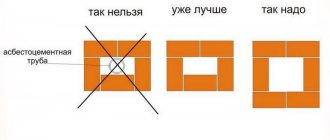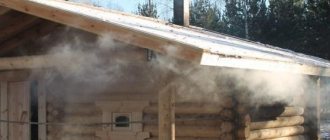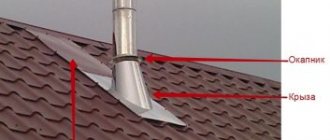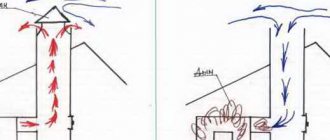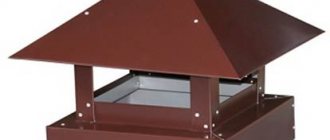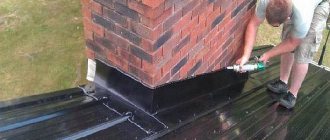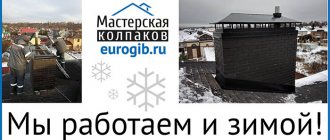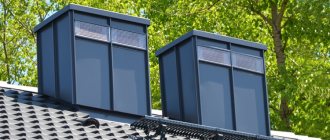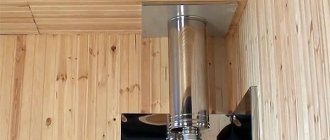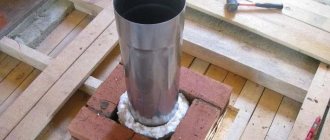Asbestos pipes are a simple, affordable and very effective solution for many communications. They have proven themselves excellent as chimneys. They are not demanding on the quality of the connection, can come into contact with different materials, and are capable of serving for a sufficient number of years, fulfilling their functions. However, many users have a question: do they need to be insulated? And if so, what materials should be used for this?
We will answer all questions further, covering the topic of insulation of asbestos pipes.
Risks of installing asbestos chimneys
Before choosing a specific product as a chimney, it is necessary to study the risks that arise during its operation and the possibility of using it for certain purposes. So, when installing an asbestos chimney, there is a possibility:
- When exposed to high temperatures, an asbestos chimney may burst. There were even cases when it exploded;
- the appearance of an unpleasant odor that occurs when harmful condensation and soot are absorbed;
- inability to install special hatches for cleaning and monitoring the condition of the chimney;
- difficulties in removing soot that occurs during the combustion process;
- thin-walled material does not contribute to the formation of draft, as a result, the boiler may not work well.
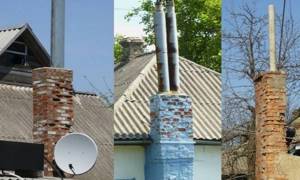
After all, this is an element of the heating system, which must work flawlessly. Improper operation of such a chimney can lead to a fire or carbon monoxide poisoning that accumulates in the pipe. That is why, before installing a chimney from an asbestos pipe, it is worth weighing all the pros and cons. And figure out in detail whether it is worth risking your health and property by installing a product that may not be intended for such purposes. Article Rating
Advantages of an insulated chimney
After building a house and insulating the roof from the inside, do not forget about the chimney on the roof. It is necessary to insulate the chimney pipe, since it is exposed to atmospheric factors. In winter it freezes, and in summer it gets hot. Correctly performed insulation will help reduce the negative impact.
Advantages of chimney insulation:
– heat loss will be reduced; – the roof near the pipe will not be damaged; – the structure will not collapse for a long time; – an insulated pipe will look more aesthetically pleasing.
A properly constructed chimney made from an asbestos pipe
The misconception that installing an asbestos pipe as a chimney is not difficult can lead to many undesirable consequences. Boiler equipment is different, each has its own efficiency.
Therefore, before proceeding with installation, you need to carefully study all technical conditions. What a private developer must be prepared for when making a chimney with his own hands is reliable fastening of the structure, arrangement of thermal insulation of the pipe, and compliance with fire safety standards.
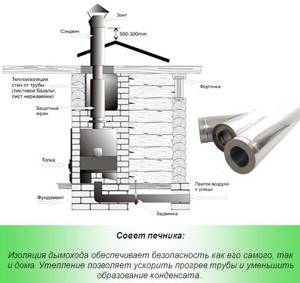
Chimney insulation
Fastening a chimney from an asbestos pipe
Installation of an asbestos pipe in the general chimney system can be carried out from the area where the temperature of the combustion products does not exceed 300 degrees Celsius. It is permissible to install both a separate riser (external chimney) and a channel passing through the roof. When arranging, you must adhere to the following rules:
- When the pipe extends above the ridge more than 2 meters, it is necessary to use additional clamps and braces for fixation;
- A separate chimney is attached to the load-bearing wall with pipe clamps at intervals of at least half a meter;
- When placing asbestos inside a brickwork channel, additional reinforcement spacers are used;
- The chimney should be secured at the point where it passes through the roof using an asbestos cement bracket.
Extension of a chimney with an asbestos channel
Free-flow asbestos pipes, which are used to organize a chimney, are usually built onto a ready-made part of the chimney made of another more heat-resistant material. The transition from metal to asbestos can be accomplished through a special stainless steel sleeve.
Connecting an asbestos pipe with a coupling
If there is an extension of one asbestos pipe to another of the same type, then the connection is made using a CAM modification coupling. The coupling has two internal grooves for a heat-resistant seal. When building up a brick chimney, the CAM coupling is fixed inside the masonry. It is supported by embedded reinforcement, and the space between the masonry and the coupling is filled with concrete.
Extension of brickwork with an asbestos chimney pipe in the absence of a coupling can be done in another way. To do this, a slab of the same asbestos cement or steel with a hole not exceeding the diameter of the asbestos channel is installed on the last row of bricks. The latter is installed on top of the hole and fixed with a solution.
Thermal insulation cushion device
Asbestos cement has a porous structure. It has poor thermal insulation qualities, so it heats up very much, to the temperature of the gases being exhausted outside. Asbestos-cement chimney pipes must be insulated with fire-resistant material for the following reasons:
- To avoid heating and ignition of flammable materials that make up the structure of the house;
- To avoid the formation of condensation, which is one of the factors that has a destructive effect on the chimney.
Basalt wool
The classic version of insulation is based on the use of basalt wool, which is wound in several layers on the chimney and secured with special clamps or knitting wire. A layer of foil is placed on top of the cotton wool. This must be done to waterproof the pipe and provide an additional fire barrier.
The insulation can be protected using a metal frame. For this purpose, thin galvanized sheet metal or with a factory paint coating is suitable. It is advisable to use such a frame for pipes protruding above the roof, where the foil will look unaesthetic.
Inserting a tee into an asbestos-cement pipe
If the chimney is arranged in such a way that it is necessary to remove it through the side wall, add a condensate drain, or install an inspection hatch to control and clean the chimney, use tees with a coupling-type connection system. After trimming the pipes and putting on the tee, the joining gap should be filled with a composition based on acid-resistant and heat-resistant components.
Sections of the chimney made of asbestos-cement pipes are prohibited from being installed in a strictly horizontal position. When the channel exits sideways, it must slope at least 3 degrees towards the boiler installation.
Thermal insulation options
To insulate a stove chimney, materials are used that provide a high degree of insulation coupled with low thermal conductivity. This eliminates the risk of “cold bridges”, icing and condensation.
Among the most effective and popular materials for insulation are the following:
- plaster - used for insulation of brick and stone chimneys. The plaster solution is applied to a previously prepared reinforced surface. In terms of labor costs and quality, this method is the least justified;
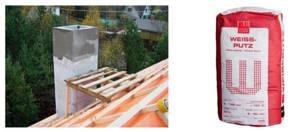
Insulating a chimney with heat-resistant plaster requires unreasonably large amounts of labor - broken brick - used for thermal insulation of brick and steel structures. The material is poured into a casing, which is secured around the chimney. The minimum distance from the chimney is 60 mm. Sometimes slag is used instead of broken brick;
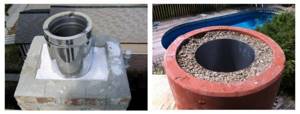
Screened slag tightly fills the installation gap and provides a high degree of thermal insulation of the chimney - basalt wool is a modern thermal insulation material produced in the form of mats or cylinders with different internal cross-sections. The material is wrapped around the chimney and secured with steel crimp clamps. In terms of price and quality ratio, this method is the most effective.
In fact, all the methods described above have some similarities - the insulation is applied or fixed to the outer surface of the chimney. After which the heat-insulating material is protected by a steel casing.
To save money, the outer steel pipe can be replaced with wood or cinder concrete slabs. For example, you can fasten a rectangular frame around the chimney using wooden boards at hand, and fill the space between the pipe and the boards with any heat-insulating material.
The first thing to remember when choosing a material for chimney insulation is that the thermal insulation must be made of non-combustible components. During operation of the chimney, the insulation will heat up to 100–150 °C, and at the point where the pipe exits through the ceilings, the temperature can be even higher.
To insulate a chimney yourself, it is better to use basalt thermal insulation. The shape and thickness of the product is selected taking into account the existing chimney structure.
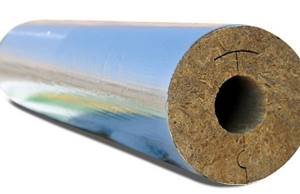
The basalt cylinder can be selected exactly to the size of the chimney pipe
The advantages of insulation based on basalt wool include:
- high thermal insulation qualities;
- good vapor permeability;
- resistance to chemicals;
- immunity to the formation of fungus and mold;
- high heat resistance when heated above 100 °C;
- environmental friendliness and safety.
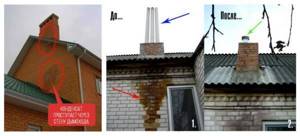
Before using ready-made thermal insulation from the manufacturer, you should carefully study its installation technology. As a rule, high-quality products are equipped with a paper insert or instructions that describe in detail the method of cutting and installation.
Before carrying out thermal insulation work, you should check the reliability and strength of the foundation that was built under the stove or other heating equipment.
After this, you should carefully inspect the place where the chimney exits through the ceilings and roof. The outlet through the ceiling must be protected by a steel box. The minimum distance from the chimney to the walls of the duct is at least 20 cm. When exiting through the roof, the chimney should not come into contact with the roof structures. To do this, you should provide appropriate spacers or a special cap that is mounted outside the building.

The chimney outlet through the ceiling must be protected by a metal box
Before you start work, you need to decide on the insulation material. You can use almost any, you just have to take into account that the chimney heats up to high temperatures, which means the insulation must be heat-resistant and non-flammable.
Gone are the days when chimneys were made primarily of brick. With the advent of gas and solid fuel boilers, they began to be made of metal, and asbestos pipes are also not uncommon. Insulation of different pipes requires an individual approach.
We invite you to familiarize yourself with: DIY steam room in a frame bath
To insulate the pipes of fireplaces and stoves that are not the main source of heating, but are used periodically, it is enough to plaster the pipe. This method is most often used for brick pipes, but is also applicable for metal ones.
For chimneys of furnaces and heating boilers, a different method is used. These are so-called sandwich chimneys. Such designs are available for sale, but they are not cheap. If you have a limited budget, you can make them yourself.
You can buy a sandwich chimney at the construction market or make it yourself
Asbestos pipes are also insulated using the same principle. In addition to mineral wool, you can use bulk insulation.
Mineral wool is considered the best insulation for asbestos pipes. This material is most often covered with a moisture-proof protective film, which is very important for asbestos because of its ability to absorb moisture. For thermal insulation with bulk material, a protective casing must be installed around the pipe, into which the insulation must be poured. To prevent moisture from entering from above, the gap between the pipe and the casing is filled with cement solution.
Brick, like asbestos, can become saturated with moisture, so it is important to think not only about insulation, but also waterproofing. The simplest way is plastering, but it is much more reliable to do this with mineral and basalt wool.
A brick chimney can be protected and insulated by plastering.
Insulation with slag concrete slabs and mortar or panel materials is also suitable.
The method of insulation needs to be thought out at the stage of constructing the chimney; in some cases, it will be necessary to lay wire for fastening into the masonry in advance so as not to spoil the brick.
Application area
It was already noted above that asbestos-cement pipes are often used for the manufacture of modern chimneys, as they can withstand high temperatures, but only if it does not exceed 300 degrees. But you should not pay attention to this limitation, since the temperature does not exceed 300 degrees.
To understand why such a product can be dangerous, it is necessary to understand what processes take place inside the chimney pipe. As a result of the combustion of solid fuel, soot accumulates on the walls of the product. If the surface is not smooth, then much more of it accumulates, since all the conditions for good adhesion have been created. From this we can draw some conclusions:
- The inner walls of an asbestos cement pipe have a rough surface, so over time a large amount of soot accumulates on them, which can lead to fire.
- If the accumulated soot ignites, the temperature inside the chimney will increase. As a result, there is a risk of explosion.

https://youtube.com/watch?v=szmulHvRejU
Maintenance problems
To avoid fire, the chimney pipe must be cleaned periodically. But asbestos-cement construction is difficult to clean, compared to analogues made from other materials.
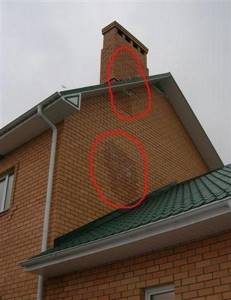
Condensate
Some experts argue that an explosion can only occur with old heating equipment. After all, modern devices have a fairly high efficiency, so the temperature does not exceed 100 degrees. From this we can conclude that an asbestos-cement pipe is suitable for making a chimney. But it is necessary to take into account all the processes that occur inside the structure under certain conditions.

- Indeed, the efficiency of modern furnace equipment is much higher, therefore, the heat goes to heating the room, and not into the chimney.
- To maintain a fire, when using any type of fuel, oxygen is needed from outside. Therefore, you need to understand what affects cravings.
- Some people mistakenly believe that the chimney is only intended to allow all combustion products to exit through it. But it is also designed to supply air to ensure the combustion of wood. As a result, normal traction is formed.
- The greater the difference in temperature between the pipe and the outside air, the less and worse the draft.
The reason for this is condensation. An asbestos-cement pipe is resistant to moisture, but you need to understand that condensation is not water. It is a solution that is formed from water and oxidized fuel combustion products.

Damage to chimneys made from asbestos pipes
- Oxidized products contain hydrochloric acid, which leads to the destruction of the material, asbestos and brickwork are no exception.
- As a result of destruction, depressions appear on the pipe where a large amount of soot accumulates. These disturb the smooth surface.
- As a result, traction deteriorates significantly, since there is no normal influx of air masses.
- This results in the fuel not being able to burn completely. Therefore, the equipment does not function properly and condensation forms on the pipe.
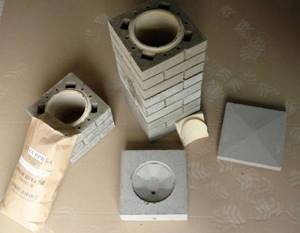
Consequences of use
The asbestos structure absorbs condensation, which negatively affects the building. As a result, stains with an unpleasant odor appear on the surface of the wall.
If you do not pay attention to this and continue to operate faulty equipment, the chimney duct may completely collapse. To eliminate the problem it is necessary to replace asbestos pipes and the destroyed part of the building
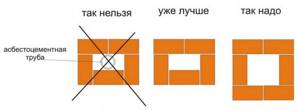
Chimney destruction
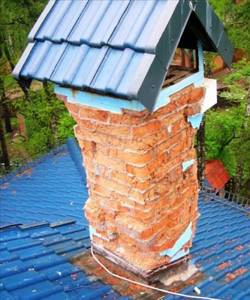
Damaged chimney
So, the destruction of the chimney occurs for several reasons, which we will now consider, and based on the information received, we will try to take a number of measures:
- The main reason for chimney destruction is dampness. Where does it come from if the chimney itself is a warm place? It's simple: not all the moisture rising with warm air escapes into the atmosphere. Some of the vapor deposits settle on the inner walls of the pipe (metal, brick, etc.), thereby condensing (converting) into permanent moisture.
- The second reason is the formation of aggressive substances that appear during fuel combustion. Many experts compare their effect with the effect of acids and alkalis. With prolonged inactivity of the chimney, aggressive “acids” deposited on the walls of the structure begin to be absorbed into the structure of the chimney walls, gradually destroying them and rendering them completely unsuitable for further use.
In both cases, chimney pipe insulation can help, as it can delay (or stop) destructive chemical processes.
How to increase safety when using asbestos pipes
One of the easiest ways to protect your home is to use asbestos chimney sandwich pipes, which are a closed system using an external casing and insulation.
The use of such structures provides many advantages. Insulating the outer part of the chimney can significantly reduce the amount of condensate formed. This makes it possible to significantly increase the service life of the asbestos-cement pipe. The outer side of the chimney, which is usually made of galvanized metal, coupled with a layer of thermal insulation material, makes the chimney structure as airtight as possible. This ensures that in the event of a seal burnout or significant cracks appearing, combustion products will not enter the room. A sandwich shell in which an asbestos-cement pipe is placed can provide additional protection for the structure of your home in the event that the material cannot withstand high temperatures and bursts. Also, the heat insulator will prevent small pieces of pipe from flying away that break off from the chimney when heated. In addition, sandwich pipes have a rather aesthetic appearance; they can easily fit into the overall design of the building.
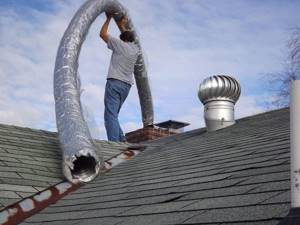
Another important factor is protecting the health of the people living in the home. Scientists are still debating whether asbestos releases substances that poison the body. It is difficult to say how true this thesis is.
However, you can protect yourself, because an asbestos pipe enclosed in a casing made of metal and insulation will definitely not be able to release harmful substances into the room.
Sandwich-type structures are recognized as the most reliable way to make joints between a chimney pipe and ceilings. Their use eliminates the possibility of elements heating to critical levels that could lead to a fire.
Do not forget that a large number of shortcomings can be found in any material, even the most modern. It is necessary to be able to find the correct balance of advantages and disadvantages and, based on this indicator, make a decision on the choice of a particular material.
The disadvantages of asbestos-cement pipes can largely be compensated for by ease of installation and low cost. In addition, the manifestation of its shortcomings can be minimized. In conclusion, it can be noted that the use of a sandwich structure is far from the only way to “improve” asbestos-cement pipes. Similar DIY designs can play the same role.
Swollen capacitors - troubleshooting computer problems

Article for computer novices: Educational program for dummies: swollen capacitors are the cause of all troubles (step-by-step solution to radio engineering problems: where to look, how to recognize and replace with your own hands and without extra costs)
Hello, dear friends! So many articles have already been written about computer malfunctions, but, unfortunately, the problem still remains open: there are too many options for its occurrence! In this article I want to touch on another aspect of this problem, which few people pay attention to. The fact is that problems with starting a computer are not only of a virtual nature (I mean purely software failures). The problem also often occurs due to failed microcircuits and capacitors. So, let's get to the main point!
Scope of application
Asbestos-cement pipes are used in various fields of construction. For example, they are used in the construction of sewage drains, both pressure and non-pressure. They often serve to supply water, both drinking and technical. Such pipes can also be used in the construction of a hot water supply system.
We recommend that you read: PPU insulation for pipes in PE sheath
In addition, asbestos-cement pipes are used in agriculture. There they are necessary when installing a reclamation system and drainage structures. In private houses, they are used to build wells, using them as casing pipes. In apartment buildings, there is another area of application for asbestos-cement pipes, in addition to water supply and sewage collection. These are garbage chute pipes. They are designed for both solid and liquid waste.

Due to the fire resistance of both asbestos itself and the structures that include it, such pipes are used for the construction of chimneys. However, there are several limitations in this application. In general, asbestos cement is used wherever there is a need for waterproofing, heat resistance, wear resistance and durability.
Types of thermal insulators made of basalt wool
The choice of the type of heat insulator made of basalt wool depends mainly on the design of the chimney, design features, as well as the requests of the owners of the room regarding thermal characteristics.
Basalt insulation for chimneys is produced in the form of cylinders and shells, mats, rolls and cardboard. Also, basalt wool can be with or without an additional foil coating.
Basalt cylinders and shells
This form of release has found its application in systems for home and industrial heating of premises. Designed for emission temperatures not higher than 300 o C.
It can be used in two ways: for external and internal thermal insulation.
Depending on the brand, it varies in thickness and length: it can be sold in rolls by the meter or optionally upon order.
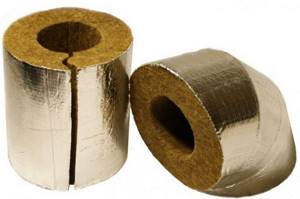
Basalt wool mats and rolls
This option is suitable if the contact temperature with the material fluctuates between 450-700 o.
It is not recommended for use on chimneys that will pass through walls, but it is suitable for other heating pipe configurations with non-standard diameters and layouts.
Basalt fiber cardboard
Basalt cardboard is the best option for insulating brick chimneys. It is capable of withstanding ultra-high temperatures up to 900 o C. One cardboard sheet can be 5-19 mm in thickness.
It is easy to install and is highly resistant to moisture and vibration. After installation, its service life reaches 50 years.
You can choose a material with or without a foil layer. Foil is required for external insulation and to achieve certain characteristics.
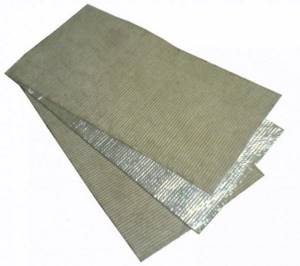
How to use asbestos chimney pipe?
Is it possible to construct a smoke duct from asbestos-cement pipes? Yes. But to avoid harmful effects, two conditions must be met:
- Installation of such a channel is recommended only in those areas that are significantly removed from the heating device. For example, only as a final section.
- When designing, it is necessary to provide for insulation and insulation. Often brick protection is installed for such a chimney. The second option is a sandwich with an external casing.
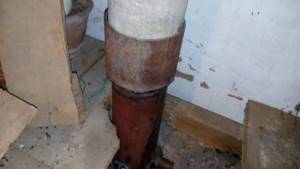
These measures will help avoid possible fires and protect against consequences associated with unsafe material. Nowadays, asbestos-cement pipes are used much less frequently if we compare our time and what happened 30-40 years ago. Experts do not recommend making such a chimney: its effective operation is only possible if heating devices are used periodically rather than constantly.
Gas boiler pipe insulation
In order to select insulation for the chimney of a gas boiler, it is necessary to select and use equally high-quality, non-combustible materials. The most common option is to use sandwich pipes. The design of which consists of two pipes with different diameters. This is necessary so that a product with a large cross-section fits into the second one, and thereby forms an additional protective layer.
How to insulate a metal chimney pipe - materials and instructions:
- It is necessary to make small holes on the roofing. Their cross-section should exceed the diameter of the chimney by approximately 25-30 centimeters;
- We produce insulation using basalt wool. There should be no gaps left after the winding;
- We additionally fix the insulation with wire;
- Large pipe casings must be secured with tapes and ties;
- The metal sheet located near the riser must also be insulated with asbestos, expanded clay or clay.
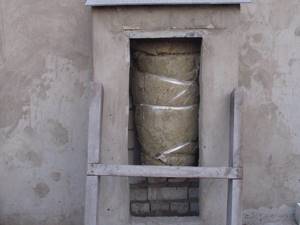
Chimney insulation with mineral wool
Chimney insulation with mineral wool
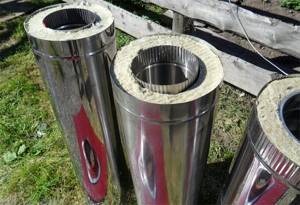
Non-combustible chimney insulation
Non-combustible chimney insulation
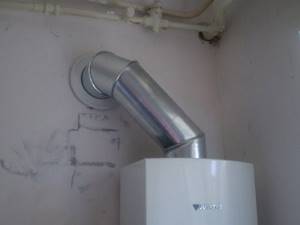
Insulation of a gas boiler chimney
Insulation of a gas boiler chimney
One of the most important elements of any stove and fireplace is the chimney, which you learned how to insulate from this article. By following the instructions and recommendations, you can complete all the work on your own, with minimal time and money costs.
Causes of chimney blockage
If the pipe in the bathhouse is clogged with soot, there are several reasons for this. Its deposits settle inside the chimney during combustion, although ideally this should not happen: all solid particles should be removed. Unfavorable conditions are to blame for these consequences. The causes of clogged pipes are:
- Undried firewood. If the humidity is more than 24%, then when they burn, steam is released along with the smoke, which is encountered in the chimney with cold air. The result of the “rendezvous” is the formation of condensation, which instantly settles on the walls, and solid particles of smoke readily adhere to it. The more often the owners use wet firewood, the more “deposits” are formed inside the pipe. The chimney section is slowly but surely closing off. If you don't take action, it will soon become completely clogged.
- Using a variety of waste as fuel - scraps of plywood, chipboard, etc. Such materials containing chemical binders provoke the formation of sticky soot. It is optimal to heat the sauna stove with dry hardwood. It is also better not to use coniferous plants, the reason is the resinousness of the wood, which leads to a similar result.
- Lack of insulation in the section of the chimney that is close to the street. Hot smoke passing through a cold pipe causes condensation to form; the consequences of this phenomenon are described above.
- Pipe bends and turns, horizontal sections. These are ideal places for soot to appear and “multiply”. Therefore, in such problem areas it is necessary to cut out small hatches to remove soot.
- Brick chimney. It is more “friendly” to deposits, since the surface of such a pipe is rough, which allows soot to settle on its walls without much effort.
If the cause of the problem is found, then it is better for the owners to try to eliminate all unfavorable conditions in the near future. Otherwise, the soot will become a permanent “settler” of the chimney: it will have to be cleaned constantly.
How and with what to insulate other structures?
The most difficult work will be faced by the owners of a brick chimney; metal may not require additional manipulations at all. But in any case, the main requirement for insulation is its non-flammability.
Thermal insulation for brick structures
There are two options. It is possible to insulate with mineral wool (or cotton wool varieties) or plaster, but in the latter case the work will take more time and require effort from the master.
Using cotton wool
The simplest option is to fix mineral wool (glass wool, basalt) with tape. After wrapping, the insulation is “hidden” under cinder concrete or asbestos-cement slabs. Or they leave it open altogether. This is not the best option, even for an attic.
Application of plaster
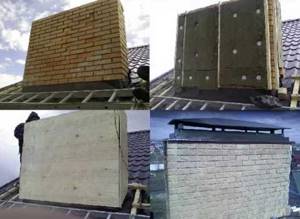
All work consists of several stages, very extended in time.
- First, a reinforcing mesh is fixed on the walls of the chimney with dowels, then a solution consisting of fine slag, cement and lime is thrown onto it. The maximum layer thickness is 30 mm. Cover all surfaces at once.
- Mineral wool is attached to the slightly dried solution, then the solution is again poured, which is pressed in with a fiberglass reinforcing mesh. Then wait for the layer of plaster to dry completely.
- After the solution has set, the surfaces are leveled, this time the layer of solution is made thinner. Dried walls are treated with a primer: at least twice with a break to dry the composition.
The last stage is painting the chimney. Often, facing bricks, stone, artificial or natural, decorative plaster or porcelain tiles are used to decorate chimneys.
Insulation of metal pipes
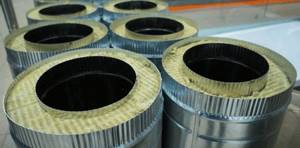
Many iron structures do not require additional manipulations, because there are products on sale that can be called semi-finished products. They consist of two pipes, with thermal insulation material already laid between them.
If such a design is not available, then such a product is not too difficult to create yourself. To implement the plan, they buy a pipe that is 60-80 mm larger than the diameter of the chimney. It is put on the canal, then fixed to the base. The space between the elements is filled with light bulk or fibrous insulation.
An alternative is to use the same mineral wool as a sandwich filling. If the roofing system is reliable enough to withstand the additional load, then heavy “filling” can be used as a heat insulator: for example, screened slag or broken brick.
Step-by-step insulation technology
Due to the fact that chimneys come in different types and designs, we will describe how to properly insulate a chimney pipe made of brick, asbestos cement and steel.
Chimneys made of asbestos cement
Asbestos cement pipe
To understand how to insulate a chimney from an asbestos pipe, we will analyze the entire procedure step by step, following the recommendations of professional builders:
First, you need to thoroughly clean the work area from dust and dirt; The next step is to make a special folding casing for the insulation (made from galvanized iron)
When determining its parameters, it should be taken into account that at least 6 cm should remain between the pipe and the iron for insulation; Pay attention to the fact that a casing assembled from several parts is put on the asbestos pipe, and each of them should not exceed 1.5 m; First of all, you should secure the lower part of the casing and carefully fill it with sealant. Then, the second part is put on and the procedure is repeated. This design must run along the entire length of the asbestos pipe.
This design must run along the entire length of the asbestos pipe.
Thermal insulation diagram from a home craftsman
This is what an asbestos chimney with a casing looks like
Often, many cottage owners do without a casing. The pipe is simply wrapped in a roll of mineral wool and secured with staples. In order for this method of insulation to become truly reliable, several layers should be wound.
Steel chimneys
So, we seem to have sorted out the asbestos pipes, now let’s see how to insulate the metal chimney pipe. In general, many manufacturers of building materials produce ready-made chimneys made of stainless steel. The design is quite simple and consists of only two pipes of different diameters.
How to insulate a metal chimney? To do this, take a pipe of smaller diameter and insert it into a pipe of larger diameter. Then, the remaining space between the pipes is filled with any of the above types of insulation. If you are interested in modern materials, then we can recommend basalt chimney insulation, which in its structure resembles mineral wool, but is much more practical and durable.
Thermal insulation of a steel chimney
In principle, it is much easier to insulate an iron pipe than an asbestos pipe, so there should be no problems here.
Brick chimney
Brick chimney
Insulating a brick chimney is perhaps the most complex type of all presented in this article. Now we will present several options, from which everyone will choose for themselves how to insulate a brick chimney:
Plastering method. To do this, you will need to attach a reinforced mesh to the chimney. Then prepare a solution of lime, slag and a small portion of cement. Spread the resulting solution over the entire surface of the chimney and level it (all work is done in one layer, which should be at least 3 cm).
When the solution dries, you can add a few more layers and immediately cover up the resulting cracks. To give an attractive appearance, the pipe can be whitewashed or painted in the future.
Thermal insulation diagram of a brick chimney
Insulation with mineral wool. To do this, you will need to take a roll of basalt wool and cut it into pieces that correspond to the dimensions of the chimney area. Then, the insulation is glued to the pipe using tape. The last step of the work is to lay insulation (for example, Rocklight) with a second layer of bricks or asbestos-cement slabs.
The process of thermal insulation of a chimney with mineral wool
Good luck!
Do-it-yourself insulation - procedure
Before you start installing thermal insulation, prepare everything you need for work. Clean the pipe from dust, repair cracks and chips
It is important that the surface is dry, otherwise the quality of thermal insulation will decrease
Plastering
The mixture is mixed with water using a construction mixer in the proportions specified by the manufacturer. It is better to first pour water into the container and then add the dry mixture. Using a spatula or trowel, the solution is applied in spots over the entire surface of the pipe and leveled. The plaster solution is leveled over the entire surface of the pipe
The pipe is covered with a reinforcing mesh along the spots of the solution, which will secure it to the surface. The mesh is necessary to strengthen the plaster layer; it plays the role of a frame. The first layer of plaster is applied on top of the reinforcing mesh
It is important that it covers the entire surface without gaps. In order for the layer of plaster to adhere to the surface of the chimney, a reinforcing mesh is used
The plaster is leveled and left to dry. After this, several more layers are applied, each of which needs to be dried. For good thermal insulation you will need 3-5 layers. After the last layer has dried, the pipe is painted in the color of the roof for aesthetics.
Video: plastering and insulating the chimney
Lining or sandwich chimney
- To do this, you will need a steel or galvanized pipe with a diameter 6-10 cm larger than the chimney and mineral or basalt wool.
- The chimney is wrapped with a layer of insulating material. The layer thickness must be at least 5 cm, the winding is overlapped.
- The layer of cotton wool is fixed with turns of wire or foil tape.
Shelling is done using insulation and pipes of larger diameter - A protective casing is placed over the insulation. It is recommended to secure the thin metal sleeve with adhesive tape and tightening straps.
- A gap is left between the upper edge of the protective casing and the insulation, which is filled with cement mortar to protect the wool from moisture.
Lining a brick chimney
The method described above is suitable for metal and asbestos chimneys; brick chimneys will require a lot of effort and time.
- The insulation mats are cut to the size of the chimney walls and attached to them using binding wire or tape.
In some cases, sheathing may be necessary. To insulate a brick pipe, lathing is sometimes required - The outside of the chimney is lined with brick, cinder blocks, and sheathed with metal siding or asbestos concrete slabs.
Insulation with bulk materials
- A casing is constructed around the chimney. Depending on the material, it can be round or rectangular in cross-section.
- The gap between the casing and the pipe is filled with sand, expanded clay or broken brick.
- Cement mortar is poured on top to prevent moisture from entering.
For insulation with expanded clay and other bulk materials, a casing is required
Such simple work will not only protect the chimney from destruction and extend its service life, but will also help to significantly save money by minimizing heat loss.
Asbestos chimney installation
The chimney is installed in the following order:
- An asbestos pipe should never be removed directly from the kiln; it should rest on a concrete or brick base. The supply to the heating unit is made through a metal adapter. This part of the chimney is equipped with a flat damper or disc damper to regulate the draft by reducing the passage in the smoke exhaust channel.
- When installing a chimney, a container is provided in its lower part to collect condensate, which must be periodically emptied of black liquid with an unpleasant odor.
- The upper end of the chimney must be equipped with a cap, and in the best case, with a deflector.
- At the junction with the chimney, a hatch is cut out in the ceiling, which is at least 15 centimeters larger than the dimensions of the pipe. A sheet metal damper is fixed to the ceiling below. Basalt wool is placed tightly into the resulting opening from above and covered with the same metal sheet on top.
- Crossing the roofing pie is done in the same way. Only on the outside of the roofing you need to install an otter - a device to prevent water from entering through the pipe into the under-roof space. On the construction market it is easy to purchase a ready-made structure that matches the size of the pipe and the slope of the roof.
It should be remembered that chimneys made from asbestos pipes should absolutely not be used when installing heating in a bathhouse due to stoves with extremely high heating temperatures.
Fire safety
The requirements for a safe chimney installation do not differ from those for other systems:
- The passage of the smoke duct closer than 70 centimeters from the load-bearing structures of the building is not allowed.
- Chimneys cannot be painted with oil or enamel paint. If necessary, you can use lime or a special bitumen varnish.
- When a chimney passes through a wall, it must be finished with non-combustible material, and the passage itself must be sealed in the same way as a ceiling passage.
It should be remembered that the industry does not produce asbestos-cement pipes specifically for chimneys and the owner himself bears responsibility for their use in the heating system.
Video: consequences of improper use of an asbestos chimney
An asbestos chimney should be inspected monthly and, if necessary, cleaned of soot.
What is especially important is that for chimneys made of asbestos pipes on solid fuel stoves, some preventive measures aimed at preventing planting are categorically not recommended. Do not use high-temperature fuel (aspen) or walnut shells to burn soot in the chimney, even in pyrolysis ovens
For this purpose, you need to use potato peels, rock salt or a blue mixture, which chemically destroys the soot layer.
Insulation of asbestos chimney
The purpose of insulating an asbestos chimney is to increase the temperature of the flue gases to reduce the amount of condensate released. The possibilities of this technique are not limitless, since at temperatures above 300 degrees the asbestos pipe begins to collapse.
- The outer part of the pipe is insulated with mineral or basalt wool, on top of which a galvanized steel casing is placed. The advantage of this method compared to brick otter is the large difference in the weight of the structures.
- The internal parts are insulated in the same way; the construction of a protective shell is not necessary here.
Types of gas flues
Depending on the material used, gas chimneys are divided into several types, while brickwork is practically not used for gas removal.
However, brick is often used for piping the exhaust pipeline. This is not a simple facing brick - it has a square shape, and its inner part has a round cross-section.
Metal chimneys are the most popular. The most commonly used material is stainless steel, which is characterized by high corrosion resistance.
Stainless steel chimney pipes are easy to install and highly corrosion resistant to any aggressive environment
The main advantages of stainless steel structures:
- Resistance to condensed moisture;
- Resistance to precipitation;
- Chemical resistance to soot resulting from gas combustion;
- Resistant to high temperatures;
- The internal smooth surface reduces the coefficient of friction, ensuring the unhindered passage of gases with minimal soot deposition;
- Light weight allows the use of standard fasteners;
- Simple installation eliminates the difficulty of carrying out work with significant destruction of walls;
- Quite affordable price.
It is not recommended to use conventional stainless steel pipes. This is due to the fact that chimney pipes are made from special grades of stainless steel, which, due to the introduction of alloying elements, are highly resistant to acids resulting from the formation of condensation.
Currently, a brick chimney is used much less frequently, because... built mainly for brick kilns, and they are actively being replaced by gas models. In addition, it takes a lot of time to set it up.
Along with this, a brick chimney has the following disadvantages:
- Rough internal surface, promoting the accumulation of soot and reducing traction;
- Instability to corrosion by acid. Due to the hygroscopicity of the material, condensation is absorbed and quickly destroyed;
- Difficulty of construction. Masonry from piece building materials takes much more time than assembling metal or ceramic modules.
The negative qualities of a brick chimney can be eliminated by inserting a sleeve in the form of an asbestos or stainless steel pipe.
Previously, asbestos-cement pipes were very widely used in the construction of chimneys for gas boilers. Despite the porosity of the material, the roughness of the internal walls and the far from ideal cross-section, the popularity of asbestos-cement pipes is due to their low cost.
A chimney made of asbestos-cement pipes has a low price, but for reliable operation it requires a strictly vertical location
To avoid these disadvantages, a chimney made of asbestos-cement pipes should be as straight as possible with sealed joints. Simple cement mortar is not enough here; dried joints must be treated with sealant or special sealed clamps must be used.
In general, the work is not difficult. If the joints are properly sealed, a chimney made from asbestos-cement pipes will be in no way inferior to its stainless steel counterpart. However, during active use it will serve no more than 3-5 years, after which it requires mandatory replacement.
Chimneys made from ceramic pipes are reliable, durable, and highly corrosion resistant to aggressive substances and temperature changes.
When installing a high chimney from a ceramic pipe, the construction of a reliable foundation is required, since they are erected according to the “root chimney” scheme
However, along with this, they have their drawbacks - heavy weight, the mandatory construction of a separate foundation and high cost. But all these disadvantages of ceramic chimneys are offset by decades of reliable and stable operation.
Asbestos pipes: pros and cons
Chimneys made from asbestos pipes are an option that became widespread back in the days of the Soviet Union. There was a “breakthrough” for a banal reason. This is cheap due to the huge deposits of “unquenchable” material and fairly simple production. Later, after the collapse of the USSR, asbestos-cement pipes were also turned into smoke ducts, although these materials are considered far from the best contenders.

Typically, they first list a candidate's strengths. The advantages of asbestos products include:
- relatively low price;
- light weight for easy installation;
- no seams and resistance to moisture.
But the list of shortcomings is much longer.
- Asbestos pipes can withstand a maximum of 300°C, so they are completely unsuitable for stoves that run on solid fuel, since in this case the temperature inside is much higher. It is 600-800°.
- The porous structure of the material facilitates the absorption of condensate that lingers on the walls. This inevitably leads to pipe destruction. Cracks in the chimney can cause a fire.
- In addition to condensation, soot accumulates in the asbestos smoke duct, which begins to burn after a certain period of time. A possible consequence is an explosion of an asbestos chimney.
- Large amounts of soot lead to a dangerous narrowing of the inner diameter. Due to the reduced clearance in such pipes, traction, which is already not the best, will only worsen.
- High-quality cleaning of the duct is somewhat difficult, since it is not possible to make an inspection hole in it to monitor the technical condition of the chimney sections.
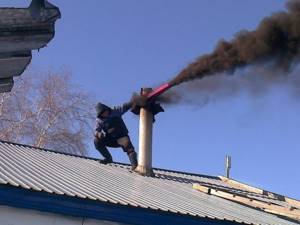
A serious disadvantage of asbestos products is that they are unsafe for health. This has been recognized by the World Health Organization (WHO). However, the greatest danger is posed by asbestos dust, not the products themselves. Pipes do not emit harmful substances when heated, so there is no real threat to the owners of such chimneys.
Chimneys and materials for their insulation
Such structures are necessary for any heating device: both solid fuel and gas. Despite the necessity of the design, not everyone pays due attention to the chimney. And in vain: it requires protection from many influences, and it also needs to be looked after regularly.

All chimneys need protection. The most common structures are made of brick, metal and asbestos-cement pipes. Any of them is in danger of gradual destruction, as it is provoked by combustion waste and caustic moisture that regularly accumulates on the walls of the channel. The question of how to insulate an asbestos chimney pipe, as well as metal or brick structures, requires a correct answer.
The choice of thermal insulation material is limited, since it must meet the requirements for heat resistance and guarantee fire safety. Neither polystyrene foam, nor its “relative” polystyrene foam, nor other analogues are suitable for this purpose. The insulation should:
- have a minimum thermal conductivity;
- be light so as not to create unnecessary load on the roof;
- be plastic, flexible, so as not to make installation difficult for the master;
- not to be afraid of precipitation, moisture, or any aggressive environment;
- have a sufficiently long service life without loss of quality.

Various materials are chosen for the role of insulation: for example, mineral wool, glass wool. They are fire-resistant and can easily withstand temperatures over 400°. Other candidates are fiber insulation or cinder boards. The most convenient are roll materials, the installation of which can be easily handled even by yourself.
The method of installing insulation for structures is different. Brick, metal and asbestos chimneys require their own material and specific technology. Naturally, when talking about thermal insulation, we mean protecting the outer walls.
The most controversial candidate on the list for the title of smoke exhaust structure is asbestos pipes, so first you need to consider them in detail, evaluate their advantages, disadvantages and potential threats.
Why do you insulate a chimney?
The chimney can be made of various materials, it can be:
- fire brick;
- reinforced concrete;
- metal;
- asbestos cement.
Metal elements are considered the most dangerous in terms of fire, so self-insulation solves two important problems: ensuring fire safety and protecting the structure from the environment. Insulating the chimney from the outside, among other things, can solve the problem of moisture getting into the attic, which will roll down the walls of the chimney during rain.
Before starting work, you need not only to purchase the necessary materials, but also to draw up a project in which the thickness of the insulation and the method of fastening the thermal insulation are determined. If you plan to insulate an existing pipe, you will have to reconstruct the roof, and in this case precision is required.
If you do not install thermal insulation on the chimney, it will quickly begin to collapse for the following reasons:
- humidity in the chimney. Moisture always appears in places where there is a temperature difference, constantly accumulating, it is converted into condensation, which, when frozen, can destroy any material, be it brick or concrete;
- the chimney is gradually destroyed by contact with the aggressive environment formed by carbon monoxide. Caustic acids and alkalis can penetrate deep into any surface.
In winter, you should not be afraid of condensation, since the room is heated every day, and the water simply evaporates from the walls of the chimney. In the spring, there comes a time when heating becomes less intense, and condensation not only settles on the walls, but also gets inside the stove structure. Therefore, you need to insulate the chimney, especially since doing it yourself is not difficult.
How to choose insulation
In order for the pipe insulation material to perform its functions, it must have the following characteristics:
- High temperature resistance. If the insulation cannot withstand elevated temperatures, it may begin to deteriorate or catch fire while heating the home.
- Tightness.
- Light weight.
- Resistance of the material to moisture formation.
- Plastic.
- Long service life of the material. If the insulation does not have a long service life, it will have to be replaced frequently.
- Low temperature resistance.
To choose the right material, you need to find out what types of insulation exist and which of them are suitable for the pipes of your home.
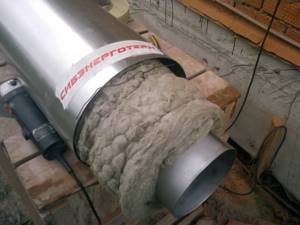
Plaster is often used for insulation. The advantages of this insulation method include:
- relatively low cost;
- aesthetics;
- accessibility for every home owner, since plastering work can be done independently.
But it is also worth remembering that the plaster will have to be changed frequently. At the same time, it is exposed to moisture and quickly collapses.
Some owners of country houses create an additional layer of brickwork. This method has several advantages. An example is a pleasant appearance and a long service life.
But many refuse this method, since it involves performing complex work and having construction experience. Often this method is combined with the laying of thermal insulation materials such as polystyrene foam or expanded polystyrene.
If the pipe is made of stainless steel or asbestos, sandwich pipes are often installed. Such products consist of two pipes with insulation between them. Condensation does not form on such sleeves. However, they cannot cause a fire. A pipe that is well insulated in this way can be used for a long time without the appearance of defects or reduction in traction.
Basic methods of insulation
We have already discussed the insulation of a metal chimney in particular above. Determine what the casing in the ceiling and on the roof will be made of. Pay special attention to places of insulation near the outlet of the pipe; in those places the greatest temperature difference is observed.
Method of insulating a steel chimney
There is no particular difference between the insulation of a stainless steel channel and the like. Also pay attention to the transition directly in the house, as well as in the insulated part of the roof. Often, many owners are careless about arranging a channel in the attic, but in most cases it is from there that the fire begins to spread. According to the advice of many experts, it is better to completely thermally insulate the channel in an unheated room.
Features of using asbestos cement products
According to the provisions of fire safety rules and SNiP, it is possible to construct chimneys from asbestos-cement pipes only in cases where the temperature to which the product is exposed does not exceed 300°C.
This is possible if:
- The product is used as the upper part of the smoke channel, into which greatly cooled gases enter.
- Asbestos pipe is used in low-power gas heating devices.
Limitations on the operating temperature are primarily due to the fact that when heated above the specified value, products made from this material burst. Consequently, its use in the initial sections of the chimney, where the temperature parameters are the highest, is strictly prohibited.
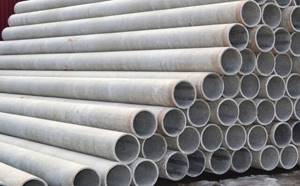
Such pipes cannot be installed in smoke shafts to remove solid fuel combustion residues from boilers.
In addition to cracking due to too high a temperature, another feature of the product is significant porosity and, as a result, accelerated absorption of accumulating condensate, leading to the destruction of the flue at the “dew point” - the base of the outer part of the pipe near the sheathing of the rafters and roof. A violation of the integrity of the surface can lead to a fire in the wooden parts of the roof frame in the area of the pipe.
What are asbestos cement pipes used for?
Asbestos cement is a durable fireproof material that combines the properties of asbestos and cement. Asbestos, or, as it is also called, mountain flax, is a group of silicate class materials that look like thin, durable threads. These threads are used as a frame into which other building materials are poured or laid. In the case of asbestos cement, such a building material is cement.
Asbestos gives strength to materials and protects them from fire. There are two types of asbestos: chrysotile and amphibole. The first is widespread in Russia, where there are asbestos deposits. This material has been used in construction for about five decades. Amphibole asbestos used to be common in European countries, but has now been banned due to its negative impact on human health.
Asbestos-cement pipes are intended for those structures where there is water, steam or gas. They can withstand temperature fluctuations and, when installed correctly, last for many years.
Advantages of using asbestos
Let's start right away with the positive qualities of asbestos pipes, which during the development of agriculture could easily be purchased (or stolen, whichever is preferable to anyone) at many enterprises and collective farms for pennies.
- Their comparative cheapness. This was due to the fact that asbestos was mined in large quantities in our country and products from it are easy to manufacture.
- They are light in weight, so they are quite easy to install.
- They do not have a seam and are not afraid of moisture.
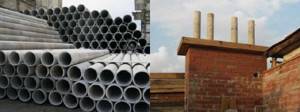
Technical characteristics and production of products
In practice, asbestos cement is fiber-reinforced concrete. Its production includes the following stages:
crushing asbestos raw materials obtained from mining enterprises; fluffing asbestos with further cutting of fibers; adding water to the ratio of cement to asbestos 85:15; removing the resulting pulp onto a drum with a mesh structure; winding the film on a rolling pin to give the product the required wall thickness.
The production of products takes place only under strict control in accordance with GOST. The weight of an asbestos-cement pipe per 1 m is from 6 to 11 kg. For example, the weight of 300 mm products is less than 500 mm.
The pressure pipe is produced in sections of 3.95 or 5 meters. Its flow section has the following dimensions: 100, 150, 200, 250, 300, 400 and 500 mm. The weight of the product varies from 45 kg for a 100 mm product to 67 kg for a 150 mm product or 19 kg for a 300 mm product.
Just like other products, the 300 pressure pipe is waterproof. The diameter of 300 mm allows for quick and cheap installation of the system.
Non-pressure products are produced in lengths of 3.95 m, the diameter of which ranges from 100 to 200 mm.
BNT 100 weighs 24 kg. Products 150 have a weight of 37 kg. The free-flow asbestos-cement pipe 200, whose weight does not exceed 64 kg, ensures a clean supply of water through the pipeline, which is why its installation is popular in the economic sphere.
What is better for a chimney - asbestos or brick?
The speed at which an asbestos pipe heats up is several times higher than brickwork, which is a plus for the first material. But ceramic brick is capable of withstanding heat up to 600-800°C, so it can be installed in a house where wood stoves and other heating devices operating on solid fuel are installed.
p, blockquote 22,0,0,0,0 —>
Installing asbestos pipes for chimneys in brick kilns is unacceptable. When heated too much, the surface will begin to crack, which can lead to a real explosion.
p, blockquote 23,0,0,0,0 —>
The asbestos pipe will have to be cleaned every few months, because... even the slightest soot deposit leads to poor traction. As disadvantages of bricks, it is worth noting: difficult installation and large mass of the structure.
p, blockquote 24,0,0,0,0 —>
In such a situation, it is best to build a brick chimney with a sealed asbestos-cement pipe. A similar design can be installed in a house where the heating source is gas and solid fuel boilers; it has good traction power and will last for many years.
p, blockquote 25,0,0,0,0 —>
User reviews indicate that the only advantage of using an asbestos chimney pipe is its low cost. As practice shows, the service life of an asbestos chimney pipe is 30 years, and even less under conditions of exposure to high temperatures and other unfavorable factors.
p, blockquote 26,0,0,0,0 —> p, blockquote 27,0,0,0,1 —>
Thus, before installing an asbestos cement pipe, you should think carefully and weigh the pros and cons. After all, the chimney duct is the most important element of the heating system, on which the quality and safety of the heating device depends.
Fire safety measures and risks
When laying an asbestos-cement channel yourself, it is necessary to strictly follow fire safety rules, since the material gets very hot and there is a risk of fire:
- The installation of a chimney in the ceiling involves making a special penetration in the form of a hole in the ceiling 10 cm larger than the cross-section of the pipe. The resulting distance is filled with non-combustible material.
- You can initially build a “fluff” and fill the gaps with broken bricks and sand.
- To protect the roof from water leakage, the perimeter of the chimney structure must be sealed with a cement compound or a special bitumen mastic must be used. Sealing cracks with silicone is excluded.
It should be remembered that it is strictly forbidden to allow heating surfaces to come into contact with load-bearing structures and sheathing elements made of flammable materials.
Errors during insulation
The most common reasons for ineffective protection are incorrect calculation of the thickness of the insulation and insufficient sealing. The first sign of poor quality work is the appearance of condensation inside the chimney duct. In this case, it is better to immediately “redo what has been done.” But try to ensure all the conditions: both the required thickness of the heat insulator and the tightness of the structure itself.
The question of how to insulate an asbestos chimney pipe can be answered as briefly as possible: with something that has a suitable weight and does not burn. For metal channels, it is better to prudently buy ready-made elements that will only need to be installed. You will have to spend quite a lot of time on brick walls.
Those who are interested in this topic will find this informative video useful:
